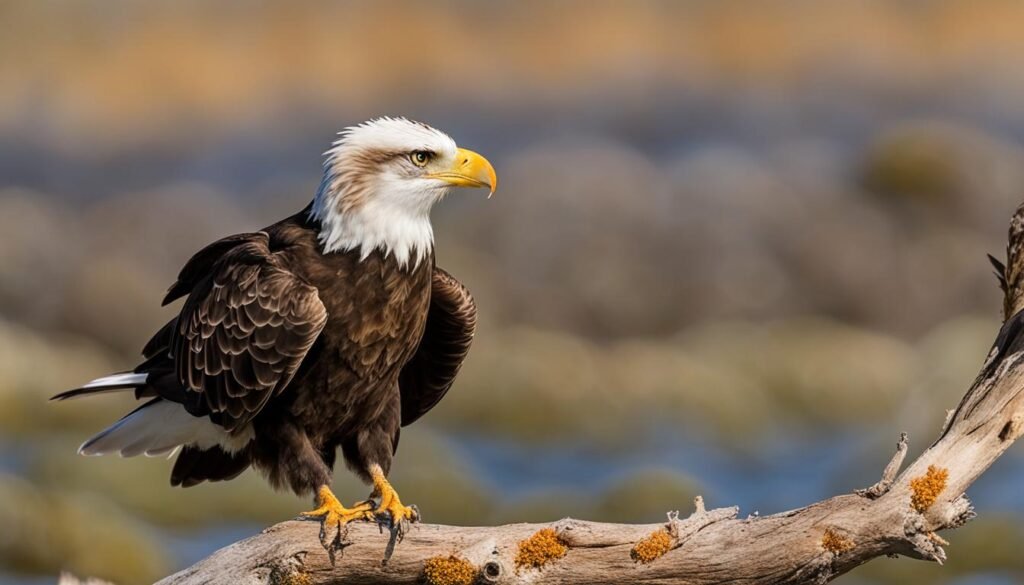Greetings, fellow bird enthusiasts! In this guide, I will take you on an exciting journey through the diverse bird species that call California their home. From the charming hummingbirds to the majestic raptors, California offers a wide array of birdlife just waiting to be discovered.
With over 600 bird species recorded in the state, California boasts a rich avian population that represents around two-thirds of all bird species in North America. Whether you’re a seasoned birder or a beginner, California provides endless opportunities for birdwatching and exploration.
California’s natural habitats are a haven for birds. From the stunning shorelines and wetlands to the enchanting oak woodlands and majestic forests, each ecosystem attracts millions of birds for breeding, resting, and migrating. The state is also home to the highest number of Important Bird Areas in the Lower 48, solidifying its status as a birding hotspot.
Key Takeaways:
- California is home to over 600 bird species, accounting for two-thirds of all bird species in North America.
- The state boasts a variety of natural habitats, including shorelines, wetlands, oak woodlands, deserts, and forests, which attract millions of birds.
- With 175 Important Bird Areas, California offers a diverse range of birding destinations.
- Several endangered bird species in California require special conservation efforts.
- California plays a crucial role in bird migration as it lies along the Pacific Flyway.
California’s Important Bird Areas
California is home to 175 Important Bird Areas (IBAs), providing crucial habitats for bird conservation. These areas span a variety of ecosystems, including wetlands, shorelines, oak woodlands, deserts, and forests. By offering essential breeding, resting, and feeding grounds, IBAs support a wide array of bird species, serving as vital lifelines for their populations. Moreover, these designated areas act as significant indicators of the overall environmental health of the state, showcasing the interconnectedness between bird species conservation and the preservation of diverse bird habitats in California.
One example of an Important Bird Area is the San Francisco Bay Estuary. Spanning over 400 square miles, this estuary serves as a critical stopover for millions of migratory birds along the Pacific Flyway. The area’s salt marshes, mudflats, and tidal wetlands attract a diverse range of waterbirds, including the endangered California Clapper Rail and the migratory Marbled Godwit. The preservation and conservation of these Important Bird Areas play a pivotal role in safeguarding the rich bird species diversity that California boasts.
- Wide Range of Habitats: From wetlands to deserts, Important Bird Areas encompass diverse ecosystems that support various bird species.
- Essential Breeding Grounds: These areas provide vital breeding grounds for numerous bird species, contributing to their population growth and sustainability.
- Resting and Feeding Grounds: Birds rely on these areas to rest and refuel during long migratory journeys, ensuring their survival and successful reproduction.
- Environmental Health Indicators: The presence and health of bird populations within Important Bird Areas serve as powerful indicators of environmental well-being and conservation success.
- Bird Species Conservation: Protecting and preserving these habitats is crucial for the long-term conservation of bird species and the overall ecological balance.
Overall, California’s Important Bird Areas are not only vital for bird species conservation but also play a significant role in maintaining the overall ecological health of the state. By protecting and preserving these habitats, we can ensure the continued presence of diverse bird species in California’s beautiful landscapes.
Endangered Bird Species in California
California is home to several endangered bird species that require special conservation efforts. The California Bird Species of Special Concern list includes 74 taxa that are ranked based on their conservation status. These species face threats such as habitat loss and degradation, which is particularly pronounced in wetlands, scrublands, grasslands, and riparian forests. The state’s southern and central coastal areas have the highest number of special concern taxa, where increasing human populations put additional pressures on these vulnerable bird species.
Conservation efforts are crucial to protect these endangered bird species and ensure their survival. The preservation and restoration of their natural habitats play a vital role in their conservation. By raising awareness and implementing measures to mitigate the threats they face, we can work towards safeguarding these precious avian populations for future generations.
Through dedicated initiatives and collaboration between government agencies, conservation organizations, and communities, California is striving to protect and restore habitats for endangered bird species. By preserving the ecological balance and the magnificent diversity of bird species, California’s efforts contribute not only to bird conservation but also to the overall health of ecosystems.
Join me in supporting these conservation efforts and appreciating the immense value of California’s endangered bird species. Together, we can make a difference in maintaining the delicate balance of nature and ensuring that future generations can witness the beauty and wonder of these remarkable avian creatures.
Bird Migration in California
California plays a crucial role in bird migration as it lies along the Pacific Flyway, a major migratory route for millions of birds. The Pacific Flyway stretches from Alaska to Patagonia, encompassing diverse habitats and providing essential stopover points for migratory birds.
During their long journeys, these migratory birds rely on wetlands, beaches, and other habitats in California as crucial pit stops for rest, feeding, and nesting. The state’s abundant wetlands, such as the Salton Sea and San Francisco Bay, are particularly vital for migratory birds, offering abundant food resources and critical resting areas.
California’s diverse range of habitats, including coastal areas, mountains, deserts, and inland forests, sustains various bird species throughout their migration journey. Birds traveling from the Arctic to as far as Chile make use of these habitats, making California a prime spot for birdwatching during migration seasons.
Birdwatching Opportunities during Migration
When migration season hits California, birdwatchers have the opportunity to witness spectacular sights as countless birds soar through the skies or gather in large flocks. As birds navigate their way along the Pacific Flyway, they bring a flurry of activity to the state’s wetlands, coastal areas, and forests.
Notable migratory birds that can be spotted during migration seasons include the Snow Geese, Sandhill Cranes, Western Tanagers, and various warbler species. These birds make striking appearances with their vibrant plumage and distinct calls, adding to the excitement of birdwatching in California.
To make the most of bird migration in California, birdwatchers can visit renowned birding hotspots such as the Sacramento National Wildlife Refuge Complex, Point Reyes National Seashore, and Mono Lake. These areas offer prime viewing opportunities and organized birdwatching events to enhance the experience.
Witnessing the grand spectacle of bird migration in California is a testament to the resilience and awe-inspiring nature of these avian travelers. Whether you’re an avid birder or just a nature enthusiast, exploring the diverse habitats of California during migration seasons can be a truly unforgettable experience.
Birdwatching Hotspots in California
California offers a plethora of birdwatching hotspots that cater to bird enthusiasts of all levels. Whether you’re a seasoned birder or just starting out, there are plenty of locations to explore and discover the diverse avian species that call California home.
One popular destination for birdwatching is the Salton Sea, a large inland lake in southern California. The Salton Sea attracts a wide variety of waterbirds and shorebirds, providing a unique opportunity to observe these species up close.
Another notable location is Point Reyes National Seashore, located just north of San Francisco. With its diverse habitats including coastal cliffs, meadows, and estuaries, Point Reyes is a haven for both resident and migratory birds. Keep an eye out for species such as the California Quail and the iconic Western Snowy Plover.
If you prefer coastal birdwatching, Malibu Lagoon State Beach is a must-visit spot. Situated along the Pacific coast, this beach offers excellent opportunities to observe a variety of waterbirds, including elegant herons, egrets, and gulls.
The Channel Islands, a group of eight islands off the coast of Southern California, are a paradise for birdwatchers. These islands are home to numerous endemic species and serve as important nesting grounds for seabirds and shorebirds. Take a boat tour or hike the island trails to witness this incredible birdlife.
For those seeking a mountainous birdwatching experience, the Sierra Nevada Mountains are an ideal destination. With their towering peaks and lush forests, these mountains provide habitat for a wide range of bird species, including woodpeckers, warblers, and raptors. Keep your binoculars handy as you explore the scenic trails.

Whether you’re drawn to coastal environments, woodlands, or mountainous landscapes, California has something to offer for every birdwatching enthusiast. Exploring these diverse habitats allows you to observe a multitude of bird species in their natural environments, creating an unforgettable birdwatching experience.
Diversity of California Avian Species
California is renowned for its remarkable bird diversity, with over 450 regularly seen species in the state. From coastal seabirds to majestic inland raptors and melodious songbirds, California offers a wide array of avian species for bird enthusiasts to explore. This rich variety is a testament to the state’s commitment to conservation and the protection of natural habitats.
With its diverse ecosystems and strategic location along the Pacific Flyway, California provides an ideal environment for the abundant bird population. The state’s varied landscapes, including shorelines, wetlands, forests, deserts, and oak woodlands, attract a plethora of bird species throughout the year.
The coastal areas are home to captivating seabirds, such as the elegant Western Gull and the charismatic California Least Tern. Inland regions boast impressive raptors like the majestic Red-tailed Hawk and the stealthy American Kestrel. Meanwhile, the forests and woodlands lure songbirds like the vibrant Western Bluebird and the melodic Hermit Warbler.
This diversity of avian species in California not only provides endless opportunities for birdwatchers but also contributes to the overall health of ecosystems. Birds play vital roles as pollinators, seed dispersers, and predators, ensuring a balanced and thriving environment.
Now, let’s take a closer look at some of the fascinating bird species that populate the beautiful state of California.
Notable Bird Species in California:
- The endangered California Condor, North America’s largest land bird, known for its impressive wingspan and critically low population.
- The stunning Anna’s Hummingbird, a year-round resident with its vibrant iridescent feathers and acrobatic flight.
- The California Scrub-Jay, an intelligent and vocal bird often found in oak woodlands, recognized for its striking blue plumage and impressive memory.
- The charismatic Western Snowy Plover, a small shorebird that nests on the sandy beaches of California and faces numerous conservation challenges.
These are just a few examples of the diverse avian species that grace the skies and habitats of California. Whether you’re a seasoned birdwatcher or a novice enthusiast, the state offers endless opportunities to explore and appreciate its vibrant bird population.
Role of Birds in Ecosystem Health
Birds play a crucial role in maintaining the health of ecosystems. From pollination to seed dispersal, they provide essential services that contribute to the overall well-being of the environment. As pollinators, birds help transfer pollen from one plant to another, facilitating the reproduction of numerous plant species.
Furthermore, birds act as predators, keeping populations of insects and small mammals in check. By feeding on these organisms, they help maintain a balance in the ecosystem and prevent the overabundance of certain species.
Birds also serve as scavengers, consuming carcasses and organic waste, thus helping to decompose and recycle nutrients. Through this important role, they contribute to the nutrient cycling process and ensure the efficient functioning of the ecosystem.
In addition, birds are key seed dispersers. As they consume fruits and berries, they ingest the seeds, which are later dispersed through their droppings. This dispersal mechanism plays a vital role in plant reproduction and contributes to the diversity and regeneration of vegetation.
Moreover, birds can act as ecosystem engineers by modifying their environment. For example, the construction of nests and burrows can create habitats for other species and contribute to the overall biodiversity of the area.
Not only do birds fulfill these specific ecological roles, but they also serve as indicators of environmental health. Due to their sensitivity to changes in their surroundings, birds often respond quickly to shifts in climate patterns, habitat availability, and food availability.
The presence and abundance of bird species in a particular area can provide valuable insights into the overall health of the environment. Declines in bird populations may indicate environmental degradation or an imbalance in the ecosystem. By monitoring bird populations, scientists and conservationists can gain a better understanding of the state of the environment and the need for conservation efforts.
Image related to Bird Conservation:

As we strive to protect and conserve our natural resources, bird conservation plays a vital role in maintaining the balance and health of ecosystems. By focusing on the well-being of bird populations, we can ensure the preservation of essential ecological functions and safeguard the overall environmental health.
Conclusion
California is a haven for birdwatching enthusiasts, thanks to its abundant bird species and diverse avian population. With its variety of habitats, important bird areas, and migratory routes, the state offers endless opportunities for observing and appreciating the beauty of its feathered residents. To ensure the continued presence of these avian species in California’s ecosystems, it is crucial to prioritize bird conservation efforts and protect their natural habitats.
By preserving the habitats that support these bird species, we can maintain the biodiversity and ecological balance that California is known for. The state’s commitment to conservation and the protection of natural ecosystems has resulted in a rich avian diversity, with over 450 bird species regularly seen throughout the region. From coastal seabirds to inland raptors and songbirds, California’s bird diversity is a testament to the state’s dedication to environmental stewardship.
So, whether you’re an avid birder or simply someone who appreciates nature’s wonders, grab your binoculars and immerse yourself in the exciting world of California birdwatching. From the majestic California Condor to the charming Calliope Hummingbird, there is a fascinating array of bird species waiting to be discovered. Experience the thrill of spotting these vibrant creatures in their natural habitats, and gain a deeper understanding of the crucial role birds play in maintaining the health of our ecosystems. California birdwatching is an adventure like no other, where every turn of the binoculars brings you closer to the magnificent avian wonders that call this state home.
FAQ
How many bird species are native to California?
California is home to over 600 bird species, accounting for approximately two-thirds of all bird species in North America.
What are some popular birdwatching spots in California?
Some popular birdwatching locations in California include the Salton Sea, Point Reyes National Seashore, Malibu Lagoon State Beach, the Channel Islands, and the Sierra Nevada Mountains.
Are there any endangered bird species in California?
Yes, California has several endangered bird species. The California Bird Species of Special Concern list includes 74 taxa that are ranked based on their conservation status.
Why is California important for bird migration?
California lies along the Pacific Flyway, a major migratory route for millions of birds. Its diverse range of habitats provides important stopover, feeding, and nesting sites for birds traveling long distances.
How many Important Bird Areas does California have?
California has 175 Important Bird Areas (IBAs), the highest number in the Lower 48. These areas play a crucial role in bird conservation by providing essential breeding, resting, and feeding grounds for many species.
How does bird diversity in California contribute to ecosystem health?
Birds play important roles in maintaining ecosystem health. They serve as pollinators, predators, and seed dispersers, and their presence and abundance can indicate the overall health of the environment.
What can birdwatchers expect to see in California?
Birdwatchers in California can expect to see a wide variety of species, including coastal seabirds, inland raptors, songbirds, and more. The state’s diverse habitats and location along the Pacific Flyway contribute to its rich avian population.
Why is bird conservation important in California?
Bird conservation is crucial for protecting the unique and diverse bird species in California. It helps maintain healthy ecosystems, preserve habitats, and ensure the continued presence of these avian species for future generations to admire and enjoy.







